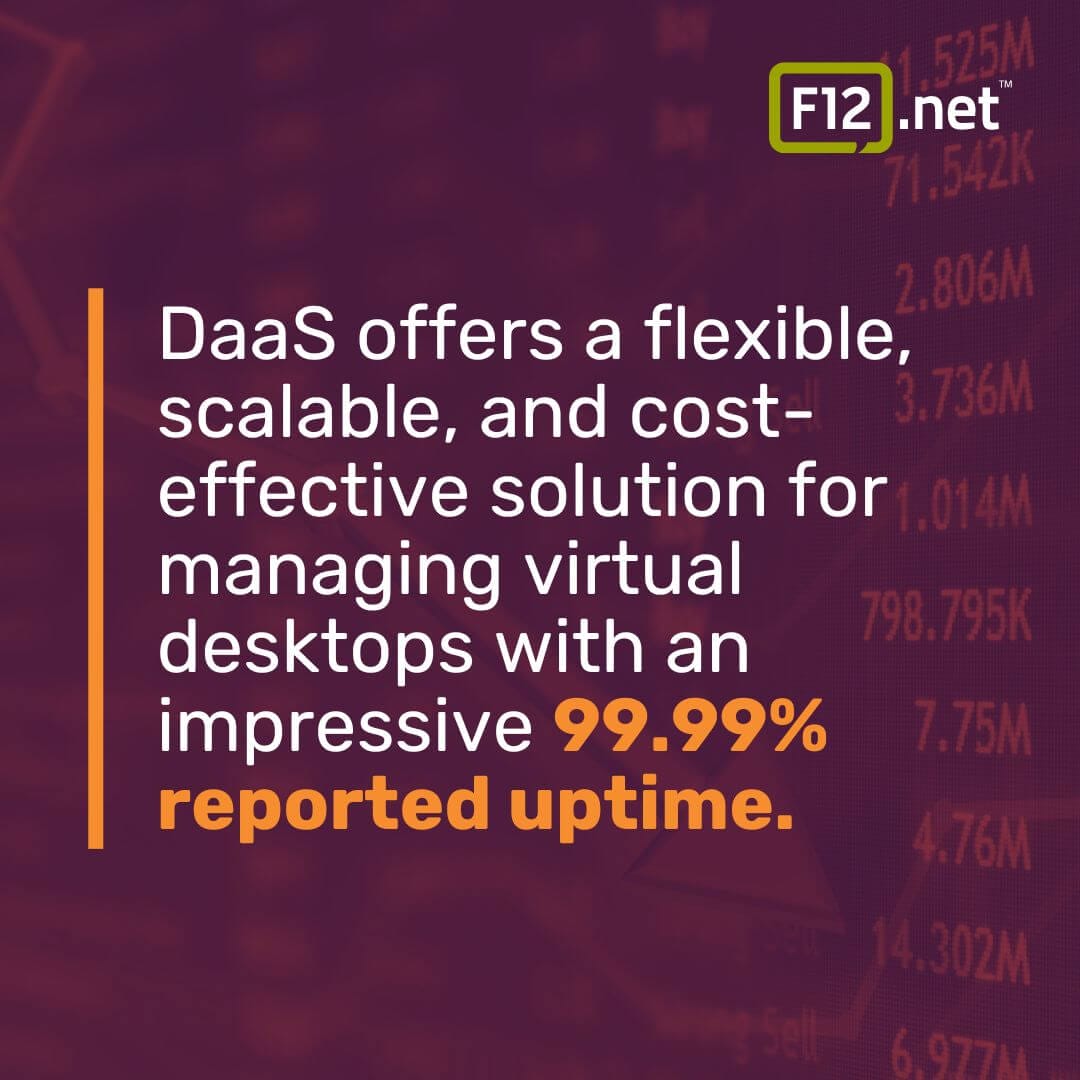Brief: Desktop as a Service (DaaS) transforms the way your organisation delivers desktops by using cloud computing. This overview covers the essential components and benefits of DaaS, how it stacks up against traditional VDI (Virtual Desktop Infrastructure), top DaaS providers, and steps to implement DaaS in your organisation.
“For our policemen, we created a race of robots. Their function is to patrol the planets-in space ships like this one-and preserve the peace.”
– Klaatu, The Day the Earth Stood Still (1951)
Much like the futuristic vision of Klaatu, where robots maintain peace across planets, the modern business world is embracing advanced technology to change the way work is done.
Desktop as a Service (DaaS) is transforming how businesses deliver desktops to their users.
Using the power of cloud computing, DaaS, also known as HaaS (Hardware as a Service), offers a flexible, scalable, and cost-effective solution for managing virtual desktops with an impressive 99.99% reported uptime.

In this guide, we’ll explore:
- The key components and benefits of DaaS
- How DaaS compares to traditional VDI
- The top DaaS providers in the market
- Steps to implement DaaS in your organisation
Whether you’re an IT decision-maker or a curious professional, this article will equip you with the knowledge to make informed decisions about adopting DaaS in your workplace.
What is DaaS?
- DaaS (Desktop as a Service) delivers virtual desktops to users over the internet, providing a fully managed, secure, and scalable virtual desktop infrastructure.
- Users can access their desktop environments from any device, anywhere, with features like multi-user compatibility and data deliverability across various platforms.
Key Components of DaaS
DaaS relies on several key technologies and components to deliver virtual desktops to users:
Virtualization Technology
Virtualization is at the heart of DaaS.
Gartner estimates that DaaS spending will increase from $3.1 billion in 2023 to $4.6 billion by 2027, indicating that companies view virtualization as the next frontier.
It allows multiple virtual desktops to run on a single physical server, each with its own operating system, applications, and settings.
This enables efficient use of hardware resources and makes it possible to quickly provision and scale desktops as needed.
The two main types of virtualization used in DaaS are:
- Virtual Desktop Infrastructure (VDI): Each user gets a dedicated virtual machine running on a centralized server.
- Remote Desktop Services (RDS): Multiple users share a single virtual machine, with each user having their own session and resources.

Cloud Infrastructure
DaaS utilizes cloud computing to host and manage the virtual desktop infrastructure.
The cloud provider takes care of the underlying hardware, storage, and networking, allowing organisations to focus on managing their desktops and applications.
The cloud infrastructure used for DaaS can be:
- Public cloud: Desktops are hosted on shared, multi-tenant infrastructure owned by the cloud provider (e.g., AWS, Azure, Google Cloud).
- Private cloud: Desktops are hosted on dedicated infrastructure, either on-premises or in a hosted data centre, providing more control and customization.
- Hybrid cloud: A combination of public and private cloud resources, allowing organisations to balance cost, performance, and security.
Desktop Management and Provisioning
DaaS includes tools and processes for managing and provisioning virtual desktops.
This includes:
- Creating and configuring desktop templates (gold images)
- Deploying desktops to users based on their roles and requirements
- Updating and patching desktops
- Monitoring desktop performance and usage
- Scaling desktops up or down based on demand.
These management tasks are typically handled through a centralized console provided by the DaaS vendor or built on top of the cloud platform’s APIs.
User Authentication and Access Control
95% of data breaches are caused by human error. Ensuring secure user authentication and access control are critical components of DaaS.
Users need to be able to access their virtual desktops from any device, while ensuring that only authorized users can access sensitive data and applications.
DaaS solutions typically integrate with existing identity providers (e.g., Active Directory, Azure AD) and support various authentication methods, such as:
- Username and password
- Multi-factor authentication (MFA)
- Single sign-on (SSO).
Access control policies can be defined to restrict user access to specific desktops, applications, and data based on their roles, location, or device type.

Advantages of DaaS
DaaS offers several key benefits over traditional desktop computing:
Flexibility and Scalability
With DaaS, organisations can quickly provision and scale desktops as needed, without having to worry about procuring, configuring, and managing physical hardware.
This makes it easier to support remote workers and their security.
Users can access their desktops from any device with an internet connection, including PCs, Macs, tablets, and smartphones. This enables greater flexibility and mobility, allowing users to work from anywhere.
Reduced Hardware Costs
By moving desktops to the cloud, organisations can reduce their upfront hardware costs and shift to a predictable, subscription-based pricing model.
This eliminates the need to regularly refresh desktop hardware and reduces the cost of maintaining and supporting physical desktops.

Simplified IT Management
DaaS offloads much of the desktop management burden from in-house IT teams to the DaaS provider.
This includes tasks such as provisioning, updating, patching, and troubleshooting desktops, as well as managing the underlying infrastructure.
This frees up IT resources to focus on more strategic initiatives and reduces the complexity of managing a diverse range of desktop environments.
Security and Compliance
DaaS can improve desktop security by centrally managing and securing desktops in the cloud, rather than on individual devices. This includes:
- Applying consistent security policies and updates across all desktops
- Storing data in secure, centralized locations rather than on local devices
- Using the security expertise and infrastructure of the cloud provider.
DaaS can also help your organisation meet compliance requirements, such as HIPAA or GDPR, by providing auditable access controls and data protection measures.
What Does DaaS Mean?
DaaS stands for “Desktop as a Service”. It is a cloud computing model that provides virtual desktops to users over the internet, typically for a monthly subscription fee.
The term “as a Service” refers to the fact that the desktop environment is delivered as a fully managed service by a DaaS provider, rather than being owned and managed by the organisation itself.
This is similar to other “as a Service” models, such as Software as a Service (SaaS) or Infrastructure as a Service (IaaS).
Benefits of DaaS
- Streamlined desktop management and user experience
- Reduced hardware costs and simplified IT maintenance
- Improved security and compliance with centralized control
Desktop as a Service (DaaS) offers numerous advantages for organisations looking to simplify their IT infrastructure and provide employees with a seamless, secure, and flexible computing environment.
With cloud-based virtual desktops, businesses can benefit from improved user experience, increased productivity, and significant cost savings.
Improved User Experience
One of the primary benefits of DaaS is the ability to access virtual desktops from any device, anywhere, at any time.
This flexibility allows employees to work remotely or on-the-go without compromising performance or functionality.
With DaaS, users can enjoy a consistent desktop experience across different locations and devices, eliminating the need to adjust to varying hardware configurations or software setups.
Seamless Application Delivery
DaaS platforms ensure that applications are delivered seamlessly to virtual desktops, regardless of the underlying hardware.
This means that employees can access their essential tools and software without worrying about compatibility issues or installation processes.
By streamlining application delivery, DaaS enables users to focus on their work rather than technical challenges, ultimately enhancing productivity and user satisfaction.
Increased Productivity
Implementing DaaS can significantly boost employee productivity by simplifying the onboarding process for new hires.
With virtual desktops, IT teams can quickly provision and configure desktops for new employees, reducing the time and effort required to set up physical workstations.
This allows new hires to hit the ground running and start contributing to the organisation’s goals from day one.
Moreover, DaaS minimizes downtime caused by hardware failures or maintenance. Since virtual desktops run on cloud infrastructure, any issues with individual devices do not impact the user’s ability to access their desktop and applications.
This ensures that employees can continue working uninterrupted, even if their physical device experiences problems.
Collaboration Tools Integration
DaaS platforms often seamlessly integrate with popular collaboration tools, such as Microsoft Teams or Zoom.
This integration enables employees to communicate, share files, and work together more efficiently within their virtual desktop environment.
By creating a collaborative workspace, DaaS helps teams stay connected and productive, regardless of their physical location.
Cost Savings
Adopting DaaS can lead to significant cost savings for organisations by eliminating the need for upfront hardware investments.
Instead of purchasing and maintaining physical desktops for each employee, businesses can use the cloud-based infrastructure provided by DaaS vendors, improving your teams cloud-based skills.
This shift from capital expenditure (CapEx) to operational expenditure (OpEx) allows companies to better manage their IT budgets and scale their desktop infrastructure according to their needs.
Pay-as-you-go Pricing Model
DaaS providers typically offer flexible, pay-as-you-go pricing models, enabling organisations to pay only for the resources they consume.
This scalability allows businesses to easily accommodate fluctuations in workforce size or project demands without over-provisioning or underutilizing resources.
By aligning costs with actual usage, DaaS helps organisations optimize their IT spending and allocate resources more effectively.
Reduced IT Maintenance Costs
Managing and maintaining physical desktops can be a time-consuming and costly endeavor for IT teams. With DaaS, the burden of hardware upgrades, software updates, and troubleshooting shifts to the service provider.
This frees up IT resources to focus on more strategic initiatives that drive business value, rather than being bogged down by routine maintenance tasks.
Additionally, DaaS often includes security measures, such as data encryption, multi-factor authentication, and regular backups, as part of their service.
This helps organisations maintain a high level of security and compliance without the need for dedicated in-house resources or expertise.
Improved Security and Compliance
DaaS offers centralized control over virtual desktops, making it easier for IT teams to enforce security policies, monitor user activity, and protect sensitive data.
With data stored in secure cloud data centres, the risk of data loss or theft due to lost or stolen devices is greatly reduced.
DaaS providers also typically employ stringent security measures, such as encryption, multi-factor authentication, and regular security audits, to ensure the integrity and confidentiality of customer data.
Furthermore, DaaS can help organisations comply with industry-specific regulations, such as HIPAA or GDPR, by providing a controlled and auditable environment for handling sensitive information.
By using the security expertise and infrastructure of DaaS providers, businesses can more easily meet compliance requirements and minimize the risk of data breaches or regulatory violations.
Comparison of Security Features of Popular DaaS Providers
| Provider | Encryption | Multi-Factor Authentication | Regular Backups | Compliance Certifications |
| Evolve IP | AES 256-bit | Yes | Daily | HIPAA, GDPR |
| Citrix | AES 256-bit | Yes | Hourly | HIPAA, GDPR, PCI-DSS |
| dinCloud | AES 256-bit | Yes | Daily | HIPAA, GDPR, PCI-DSS |
DaaS vs VDI
While DaaS and VDI both provide virtual desktops to users, they differ in their deployment, management, and cost models.
Let’s compare these two approaches to understand their key differences.
Ownership and Management
VDI solutions are typically deployed on-premises and managed by the organisation’s internal IT team.
This means the company is responsible for purchasing, setting up, and maintaining the necessary hardware and software infrastructure.
In contrast, DaaS is a cloud-based service managed by a third-party provider. The provider takes care of the underlying infrastructure, including servers, storage, and networking, and ensures the virtual desktops are always available and up-to-date.
Scalability and Flexibility
VDI deployments are limited by the capacity of the on-premises infrastructure.
Scaling up or down requires significant time and effort to procure and set up additional hardware. This can lead to overprovisioning and underutilization of resources.
DaaS, on the other hand, leverages the elasticity of the cloud to easily scale virtual desktops based on demand.
Users can be added or removed quickly, and resources can be adjusted to meet changing requirements without the need for upfront investments.
Cost Structure
Implementing a VDI solution involves high upfront costs for hardware, software licences, and infrastructure setup.
Ongoing expenses include maintenance, upgrades, and IT staff salaries. These costs can be difficult to predict and manage, especially for organisations with fluctuating user counts.
DaaS offers a more predictable and affordable cost structure. Providers typically charge a monthly subscription fee per user, which covers the cost of infrastructure, maintenance, and support.
This pay-as-you-go model minimizes upfront investments and allows organisations to treat virtual desktops as an operational expense.
| Aspect | VDI | DaaS |
| Deployment | On-premises | Cloud-based |
| Management | Internal IT | Service provider |
| Scalability | Limited | Elastic |
| Cost structure | High upfront, ongoing maintenance | Monthly subscription, pay-as-you-go |
In our comparison, DaaS emerges as the winner for organisations seeking a flexible, scalable, and cost-effective solution for delivering virtual desktops.
By offloading the management and maintenance to a service provider, companies can focus on their core business activities while ensuring their employees have access to secure and up-to-date virtual desktops.
How DaaS Works
- DaaS providers manage the infrastructure and resources to deliver virtual desktops
- Users access their desktops from anywhere with an internet connection
- IT teams can easily provision, manage, and secure desktops from a centralized console
Virtualization and Cloud Infrastructure
At the core of DaaS lies virtualization technology, which allows multiple virtual machines (VMs) to run on a single physical server.
Each VM functions as an independent desktop environment, complete with its own operating system, applications, and settings.
DaaS providers leverage this technology to create and manage a pool of virtual desktops hosted on their cloud infrastructure.
By running desktops on VMs in the cloud, DaaS offers several advantages over traditional on-premises desktop deployments.
First, resources can be allocated dynamically based on user demand, ensuring optimal performance and scalability.
If an organisation experiences a sudden surge in desktop usage, the DaaS provider can quickly spin up additional VMs to accommodate the increased workload. Conversely, during periods of low usage, resources can be scaled back to minimize costs.
Moreover, hosting desktops in the cloud eliminates the need for organisations to invest in and maintain expensive on-premises hardware.
DaaS providers take on the responsibility of managing the underlying infrastructure, including servers, storage, and networking components.
This allows businesses to focus on their core competencies rather than worrying about the complexities of desktop infrastructure management.
Advantages of Cloud-Based Desktop Virtualization
- Scalability: Easily scale up or down based on user demand
- Cost-effectiveness: Pay only for the resources consumed, reducing capital expenditures
- Reduced maintenance: DaaS providers handle infrastructure management and updates
- Geographic flexibility: Access desktops from anywhere with an internet connection
Desktop Provisioning and Management
One of the key benefits of DaaS is the simplified provisioning and management of virtual desktops.
With traditional desktop deployments, IT teams had to manually configure and maintain each individual machine, a time-consuming and resource-intensive process.
DaaS streamlines this process by providing a centralized management console for IT administrators.Through this console, IT teams can quickly create and deploy virtual desktops based on predefined templates.
These templates can be customized to include specific operating systems, applications, and settings, ensuring that each user has access to the tools they need to be productive.
As new employees join the organisation or existing users require changes to their desktop environments, IT can easily provision or modify desktops with just a few clicks.
Furthermore, DaaS providers handle the ongoing maintenance and updates of the virtual desktops. They ensure that operating systems and applications are kept up-to-date with the latest security patches and feature releases.
This relieves IT teams of the burden of managing desktop updates, allowing them to focus on more strategic initiatives.
Benefits of Centralized Desktop Management
- Rapid provisioning: Deploy desktops quickly using predefined templates
- Consistency: Ensure all users have access to the same tools and resources
- Simplified updates: DaaS providers handle OS and application updates
- Reduced IT workload: Offload desktop management tasks to the DaaS provider
User Access and Authentication
To access their virtual desktops, users typically log in through a secure web portal or client software provided by the DaaS vendor.
This allows them to connect to their desktops from any device with an internet connection, including PCs, laptops, tablets, and smartphones. The user experience is seamless, as the virtual desktop looks and feels just like a traditional physical desktop.
DaaS providers employ incredible security measures to protect user data and ensure secure access to virtual desktops.
Multi-factor authentication (MFA) is a common feature, requiring users to provide additional verification beyond a password, such as a fingerprint or a one-time code sent to their mobile device.
This added layer of security helps prevent unauthorized access to sensitive data and applications.
Additionally, DaaS solutions often integrate with an organisation’s existing identity and access management (IAM) systems, such as Active Directory or single sign-on (SSO) solutions.
This allows for seamless user authentication and ensures that access policies are consistently enforced across all virtual desktops.
Secure Access and Authentication Features
- Web-based access: Connect to desktops through a secure web portal
- Multi-factor authentication: Improve security with additional verification methods
- Integration with IAM systems: Use existing user authentication and access policies
- Encrypted connections: Protect data in transit between user devices and virtual desktops
Network Optimization and Performance
To ensure a smooth and responsive user experience, DaaS providers optimize their network infrastructure for performance.
They employ techniques such as data compression, caching, and intelligent routing to minimize latency and maximize bandwidth utilization. This is particularly important for users accessing their desktops from remote locations or over slower network connections.
DaaS providers also monitor network performance in real-time, proactively identifying and addressing any issues that may impact user experience.
They invest in high-performance hardware and network components to ensure that virtual desktops are delivered with minimal latency and maximum reliability.
Moreover, many DaaS solutions offer built-in performance optimization features, such as auto-scaling and load balancing.
Auto-scaling automatically adjusts the number of virtual desktops based on user demand, ensuring that resources are allocated efficiently.
Load balancing distributes user sessions across multiple servers to prevent overloading and maintain optimal performance.
Network Optimization Techniques
- Data compression: Reduce the amount of data transmitted over the network
- Caching: Store frequently accessed data closer to the user for faster access
- Intelligent routing: Optimize network paths to minimize latency
- Auto-scaling: Automatically adjust resources based on user demand
- Load balancing: Distribute user sessions across multiple servers for optimal performance
Disaster Recovery and Business Continuity
DaaS provides inherent disaster recovery and business continuity capabilities. Since virtual desktops are hosted in the cloud, they are not tied to a specific physical location or device.
In the event of a natural disaster, power outage, or other disruption, users can simply log in to their virtual desktops from an alternate location and continue working as usual.
DaaS providers typically maintain multiple data centres in geographically dispersed locations, ensuring redundancy and failover capabilities. If one data centre experiences an outage, user sessions can be seamlessly transferred to another location, minimizing downtime and data loss.
Furthermore, DaaS providers often offer built-in data backup and recovery features. User data is regularly backed up and can be quickly restored in the event of data loss or corruption.
This provides an additional layer of protection and peace of mind for organisations.
Disaster Recovery and Business Continuity Benefits
- Geographic redundancy: Multiple data centres ensure continuity in the event of a localized outage
- Seamless failover: User sessions can be transferred to alternate locations without interruption
- Data backup and recovery: Regular backups protect against data loss or corruption
- Rapid recovery: Quickly restore virtual desktops and user data in the event of a disaster
With virtualization, cloud infrastructure, centralized management, secure access, network optimization, and disaster recovery capabilities, DaaS provides a comprehensive and efficient solution for delivering virtual desktops to users.
Organisations can benefit from increased flexibility, scalability, and cost-effectiveness while ensuring a secure and high-performance user experience.
Top DaaS Providers
When choosing a DaaS provider, it’s important to consider factors like ease of use, security, and integration with your existing tools.
In this section, we’ll compare three of the top DaaS providers: Amazon WorkSpaces, Microsoft Azure Virtual Desktop, and Citrix Managed Desktops.
Amazon WorkSpaces
Amazon WorkSpaces is a fully managed DaaS solution that allows you to provision virtual desktops in just a few clicks.
Some key features include:
- Integration with the AWS ecosystem, including Amazon FSx and Amazon AppStream 2.0
- Support for both Windows and Linux desktops
- Pay-as-you-go pricing with no upfront costs
| Pricing Comparison | Amazon WorkSpaces | Microsoft AVD | Citrix Managed Desktops |
| Standard Bundle | $25/user/month | Free with eligible Microsoft 365 licence | $30/user/month |
| Advanced Bundle | $35/user/month | $12/user/month | $40/user/month |
| Enterprise Bundle | $45/user/month | $20/user/month | $50/user/month |
Microsoft Azure Virtual Desktop
Microsoft Azure Virtual Desktop (AVD) is a native Windows 10 experience that’s optimized for virtual desktops. Benefits of AVD include:
- Seamless integration with Microsoft 365 apps like Office and Teams
- Support for multi-session Windows 10, allowing multiple users to share a single virtual machine
- Built-in security features like reverse connect and FSLogix profile containers
AVD vs. Amazon WorkSpaces
While both solutions offer a fully managed DaaS experience, there are some key differences:
| Feature | AVD | Amazon WorkSpaces |
| Operating System | Windows 10 only | Windows and Linux |
| Integration | Microsoft 365 | AWS ecosystem |
| Pricing | Free with eligible Microsoft 365 licence | Pay-as-you-go |
Citrix Managed Desktops
Citrix Managed Desktops is a DaaS solution built on Citrix Virtual Apps and Desktops technology. Key features include:
- Advanced security features like multi-factor authentication and data encryption
- Real-time user analytics to optimize performance and user experience
- Support for a wide range of devices, including thin clients and Chromebooks
In our testing, we found that Citrix Managed Desktops offers the most powerful security features of the three providers.
However, it may be more complex to set up and manage compared to AVD or Amazon WorkSpaces.
The Winner: Microsoft Azure Virtual Desktop
After comparing these three top DaaS providers, we believe that Microsoft Azure Virtual Desktop offers the best overall value for most organisations.
Its native Windows 10 experience and tight integration with Microsoft 365 make it easy to deploy and manage, while its multi-session support helps keep costs down.
While Amazon WorkSpaces and Citrix Managed Desktops are still excellent choices, AVD’s balance of features and affordability give it the edge.
Implementing DaaS in Your Organisation
- Streamline your desktop management with a step-by-step DaaS implementation plan
- Ensure a smooth transition and optimal performance for your users
- Unlock the benefits of DaaS with careful planning and execution
After selecting the right DaaS provider for your organisation, it’s time to put your plan into action.
Implementing DaaS involves assessing your requirements, migrating users and applications, and monitoring performance to ensure a successful rollout.
By following these steps, you can minimize disruption and maximize the benefits of DaaS for your business.
Assess Your Requirements
Before diving into implementation, it’s crucial to have a clear understanding of your organisation’s needs.
This includes evaluating the number of users who will be accessing virtual desktops, the applications they require, and any specific performance or security requirements.
Number of Users and Applications
Start by identifying the total number of users who will be transitioning to DaaS. This will help you determine the scale of your implementation and ensure you have the necessary resources in place.
Next, create an inventory of the applications each user or department needs access to.
This will guide your application migration strategy and help you prioritize which apps to move first.
Performance and Security Needs
Evaluate the performance requirements for each user group or application. Some users may need high-performance desktops for resource-intensive tasks, while others may have more basic needs.
Additionally, assess any specific security requirements, such as compliance regulations or data protection policies that need to be adhered to.
By thoroughly assessing your requirements upfront, you can create a tailored implementation plan that meets the needs of your organisation and sets you up for success.
Choose the Right DaaS Provider
With your requirements in hand, it’s time to select a DaaS provider that aligns with your needs.
Evaluate each provider based on their features, pricing, and support offerings to find the best fit for your organisation.
Evaluate Features, Pricing, and Support
Compare the features offered by each DaaS provider against your requirements list.
Look for providers that offer the right mix of performance, security, and management capabilities to meet your needs.
Consider pricing models and ensure that the provider you choose offers transparent and predictable costs.
For example, Citrix DaaS offers a variety of pricing plans, including a custom plan for large-scale deployments.
Don’t forget to evaluate the level of support offered by each provider.
Look for providers with a proven track record of reliability and responsive customer service. 24/7 support can be invaluable in ensuring a smooth implementation and ongoing success with DaaS.
Conduct Proof-of-Concept Trials
Before making a final decision, consider conducting proof-of-concept trials with your top DaaS provider candidates.
This allows you to test the solution in your own environment and validate that it meets your needs.
During the trial, assess factors such as ease of use, performance, and compatibility with your existing applications and infrastructure.
Gather feedback from end-users to ensure the solution meets their needs and expectations.
By thoroughly evaluating providers and conducting trials, you can make an informed decision and choose the DaaS solution that best fits your organisation.
Plan Migration and Onboarding
With your DaaS provider selected, it’s time to plan your migration and onboarding strategy.
This involves identifying user groups, prioritizing migrations, and providing training and support for end-users.
Identify User Groups and Prioritize Migration
Start by categorizing your users into groups based on their roles, applications, and performance needs.
This will help you create a phased migration plan that minimizes disruption and ensures a smooth transition.
Prioritize migrations based on factors such as business criticality, user readiness, and application complexity.
Consider starting with a pilot group of users to test the migration process and gather feedback before rolling out to larger groups.
Provide Training and Support for End-Users
To ensure a successful adoption of DaaS, it’s important to provide comprehensive training and support for your end-users.
Develop training materials that cover the basics of accessing and using virtual desktops, as well as any specific workflows or applications they’ll be using.
Consider offering a variety of training formats, such as in-person sessions, webinars, and self-paced tutorials to accommodate different learning styles.
Establish a support system, such as a helpdesk or designated DaaS champions, to assist users with any questions or issues that arise during the transition.
By planning your migration and onboarding strategy carefully, you can ensure a smooth and successful transition to DaaS for your organisation.
Monitor and Optimize Performance
Once your DaaS implementation is up and running, it’s important to continuously monitor and optimize performance to ensure the best possible user experience and maximize the value of your investment.
Regularly Review Usage and Performance Metrics
Establish a regular cadence for reviewing usage and performance metrics for your DaaS environment.
Monitor factors such as desktop uptime, application performance, and user satisfaction to identify any areas for improvement.
Use the reporting and analytics tools provided by your DaaS provider to gain insights into usage patterns and identify opportunities for optimization.
For example, you may discover that certain applications are consuming more resources than expected or that certain user groups require additional support.
Fine-Tune Desktop Configurations as Needed
Based on your performance reviews, make adjustments to your desktop configurations as needed.
This may involve optimizing resource allocation, adjusting application settings, or migrating users to different desktop pools based on their needs.
Continuously gather feedback from end-users and use it to inform your optimization efforts. Regularly communicate updates and improvements to users to keep them informed and engaged with the DaaS platform.
By monitoring and optimizing your DaaS environment on an ongoing basis, you can ensure that you’re getting the most value from your investment and providing the best possible experience for your users.
Transforming Your Workplace with DaaS
DaaS offers a flexible, secure, and cost-effective solution for delivering virtual desktops to your workforce.
By using cloud infrastructure and centralized management, DaaS simplifies IT operations while empowering users with access to their desktops from anywhere, on any device.
Implementing DaaS in your organisation can lead to improved user experiences, increased productivity, and significant cost savings compared to traditional desktop infrastructure.
Ready to take the next step in modernizing your desktop delivery?
Contact our team of DaaS experts today to discuss your organisation’s unique requirements and explore how our cutting-edge DaaS solutions can transform your workplace.
What challenges do you currently face with your desktop infrastructure, and how do you envision DaaS addressing those issues?



